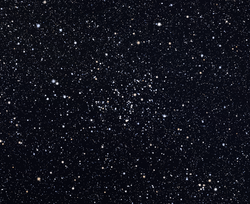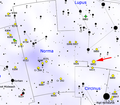Astronomy:NGC 5822
| {{{name}}} | |
|---|---|
 NGC 5822 (taken from Stellarium) | |
| Observation data (J2000 epoch) | |
| Constellation | Lupus |
| Right ascension | 15h 4m 21.(2)s[1] |
| Declination | −54° 23′ 5(8)″[1] |
| Distance | 2,682 ly (822.3 pc)[1] |
| Apparent magnitude (V) | 6.5[2] |
| Physical characteristics | |
| Mass | ~1.7×103[3] M☉ |
| Radius | 26.1 ± 1.3 ly (8.0 ± 0.4 pc)[4] |
| Estimated age | 900±100 Myr[5] |
| Other designations | NGC 5822, Cr 289, ESO 176-SC 009[6] |
NGC 5822 is an open cluster of stars in the southern constellation of Lupus.[7] It was discovered by English Astronomer John Herschel on July 3, 1836,[2] and lies close to another cluster, NGC 5823, which suggests there may be a physical association.[8][9]
NGC 5822 is an intermediate age cluster, estimated at around 900 million years old, and it is located nearby[3] at a distance of 2,700 light years.[1] The Trumpler class of this cluster is III 2m.[9] It is richly populated[5] with half the cluster members lying within an angular radius of 22.1′.[1] The cluster is considered low mass at ~1,700 times the mass of the Sun.[3] It has a core radius of 1.1±0.1 pc and a limiting radius of 8.0±0.4 pc.[4]
Measuring the abundances of a set of F-type stars that are probable members demonstrates the cluster metallicity is very similar to the Sun.[5] It displays an extended main sequence turnoff on the Hertzsprung–Russell diagram, most likely due to differences in stellar rotation.[3] Two barium stars have been identified in NGC 5822, making it only the second cluster shown to host these objects as of 2013.[10]
Gallery
References
- ↑ 1.0 1.1 1.2 1.3 1.4 Cantat-Gaudin, T.; Anders, F. (January 2020). "Clusters and mirages: cataloguing stellar aggregates in the Milky Way". Astronomy & Astrophysics 633: 22. doi:10.1051/0004-6361/201936691. A99. Bibcode: 2020A&A...633A..99C.
- ↑ 2.0 2.1 Seligman, Courtney. "NGC Objects: NGC 5800 - 5849". Celestial Atlas. https://cseligman.com/text/atlas/ngc58.htm#5822.
- ↑ 3.0 3.1 3.2 3.3 Sun, Weijia et al. (May 2019). "Stellar Rotation and the Extended Main-sequence Turnoff in the Open Cluster NGC 5822". The Astrophysical Journal 876 (2): 9. doi:10.3847/1538-4357/ab16e4. 113. Bibcode: 2019ApJ...876..113S.
- ↑ 4.0 4.1 Bonatto, C.; Bica, E. (July 2005). "Detailed analysis of open clusters: A mass function break and evidence of a fundamental plane". Astronomy and Astrophysics 437 (2): 483–500. doi:10.1051/0004-6361:20042516. Bibcode: 2005A&A...437..483B.
- ↑ 5.0 5.1 5.2 Carraro, Giovanni et al. (October 2011). "A UBVI and uvbyCaHβ Analysis of the Intermediate-age Open Cluster, NGC 5822". The Astronomical Journal 142 (4): 18. doi:10.1088/0004-6256/142/4/127. 127. Bibcode: 2011AJ....142..127C.
- ↑ "NASA/IPAC Extragalactic Database". Results for NGC 5749. http://nedwww.ipac.caltech.edu/.
- ↑ "NGC 5822". SIMBAD. Centre de données astronomiques de Strasbourg. http://simbad.u-strasbg.fr/simbad/sim-basic?Ident=NGC+5822.
- ↑ Bruck, Mary T. et al. (1968). "Three-colour photometry of southern galactic clusters IV: NGC 5822, 5823". Publications of the Royal Observatory, Edinburgh 6 (9): 209–223. Bibcode: 1968PROE....6..210B.
- ↑ 9.0 9.1 Dawson, D. W. (November 1978). "DDO photometry of giants in four southern open clusters". Astronomical Journal 83: 1424–1429. doi:10.1086/112334. Bibcode: 1978AJ.....83.1424D.
- ↑ Katime Santrich, O. J. et al. (August 2013). "Two Barium Stars in the Open Cluster NGC 5822". The Astronomical Journal 146 (2): 12. doi:10.1088/0004-6256/146/2/39. 39. Bibcode: 2013AJ....146...39K.
External links
- NGC 5822 on WikiSky: DSS2, SDSS, GALEX, IRAS, Hydrogen α, X-Ray, Astrophoto, Sky Map, Articles and images
Coordinates: ![]() 15h 04m 21.2s, −54° 23′ 47″
15h 04m 21.2s, −54° 23′ 47″
 |


